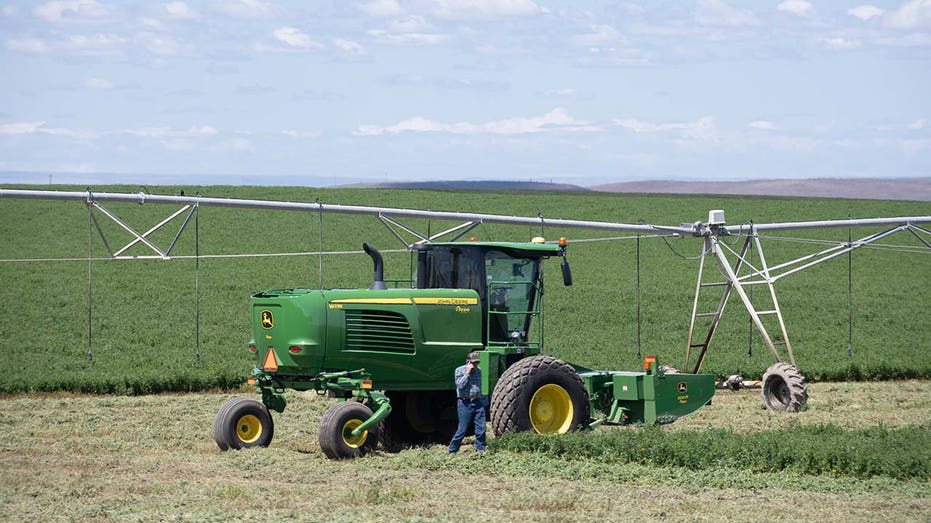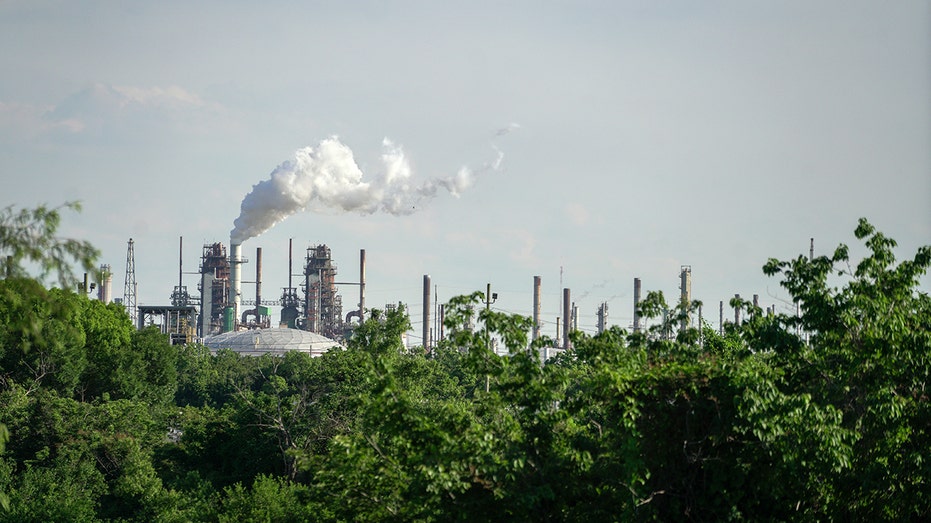High diesel prices, low supplies weighing on farmers
Gas, diesel prices putting ‘huge burden’ on farmers, everyday households: Gov. Pete Ricketts
Nebraska Governor Pete Ricketts discusses inflation and energy prices.
U.S. farmers have been grappling with high input prices for months, but soaring diesel prices and reduced inventories are top of mind for many given that fuel is one cost that is impossible to avoid for producers.
For many, the higher cost has amounted to tens of thousands of dollars.
The average price for a gallon of diesel in the U.S. hit a new record of $5.77 on Sunday, according to AAA. That was the major topic raised by farmers at the Montana Farm Bureau Summer Conference this week.
A farmer in Echo, Oregon, on May 20, 2022. (Chona Kasinger/Bloomberg via / Getty Images) "I'm hearing a lot about diesel prices," American Farm Bureau Federation economist Shelby Myer told FOX Business from the conference. "It's a necessity to use fuel in order to get the crops planted and these high prices cannot be avoided, so growers have expressed concerns about availability and delivery of diesel fuel for when they needed it most – especially as we face delays in planting in many areas." TEXAS AGRICULTURE OFFICIAL: PRICES FOR US FARMERS GOING ‘THROUGH THE ROOF’ AMID BIDEN AMID ‘COMEDY OF ERRORS’ Chandler Goule, CEO of the National Association of Wheat Growers, agrees. "One of the most important things to note about the price of diesel is it is one of the inputs that is completely unavoidable – not just for U.S. wheat farmers, but for all farmers," Goule said. "Even if a wheat grower was to reduce how much fertilizer they're buying this year because the costs or reduce other crop protection tools because of costs, they still have to plant their crop, which requires diesel, to harvest their crops, which requires diesel, and they still have to haul their grain to an elevator, which requires diesel," Goule continued. "This is one of the costs that you cannot cut back on." Myers said the Farm Bureau has been focused on tracking crude oil stocks, and noted that diesel stocks in the first week of June were down 21% compared with last year. While the U.S. typically has lower inventories this time of year due to increased demand, this year's decline points to an incredibly tight supply market, "and so any misstep can really throw that off." SEC'S PROPOSED ESG RULE WILL LEAVE SMALL FARMS IN THE LURCH, LAWMAKERS FROM BOTH PARTIES SAY Gregg Ibendahl, an economist at Kansas State University, argued that the rise in diesel costs has not had near the impact as the surge in fertilizer costs – but both are linked to oil. He said "it doesn't take much to really cause a problem in the fuel supply," like if one refinery goes down. A view of the ExxonMobil refinery in Baton Rouge, Louisiana, May 15, 2021. (Kathleen Flynn / Reuters Photos) Myers said that same thing, citing the risk "if a hurricane hits an area that refines diesel or contributes to offshore production." She said farmers largely had adequate fuel supplies at the beginning of planting season, but are now voicing concerns that they will not have the same backup supply in years past from the Gulf Coast that they normally would, because "most of those supplies are being exported." Several farmers are concerned that sky-high input prices and yield concerns could cut into profits for the year or worse, but not all economists agree on how much fuel hikes and other cost increases could impact farm income given how much the price of commodities like wheat and corn have risen. RECORD-HIGH GAS PRICES: ‘NO END IN SIGHT,’ REP. COMER SAYS "From a farmer's perspective, even though prices are a lot higher for a lot of things – diesel included – commodity prices have actually outpaced that," Ibendahl said. "Even though we're probably looking at record-high expenses for most items for farmers, I think the commodity prices have more than kept up, so I don't really anticipate farmers actually taking that big of a dip in net farm income for 2022." He also does not expect the U.S. to run out of diesel. However, Ibendahl said, particularly with the high price of fertilizer – which is also linked to the price of oil – "there's still a substantial risk of commodity prices turning, and suddenly you've got a lot of money invested and maybe no way to cover that. So that's what's become a bigger issue for farmers." Myers argued that the risk to some producers is greater than others. "Not every commodity has seen the increase in price the way that corn, soybeans and wheat have," she said. "Rice is a great example. Another great example is livestock growers: In particular, for many of our cattle producers, they are not going to see the same increase on their product as some of the row crops, but are still seeing some of the same [price increases for] inputs." A farmer spreads pesticide on a field in Centreville, Maryland, on April 25, 2022. (Jim Watson/AFP via / Getty Images) Since the beginning of the year, she noted, anhydrous ammonia is up 227% and liquid nitrogen is up 186%, but the price of corn only increased 37%. GET FOX BUSINESS ON THE GO BY CLICKING HERE As for how to fix the problem of rising fuel costs, Myers said one of the things the Farm Bureau has called for is "flexibility to the regulatory hurdles that those refiners have to face right now, so that domestic companies have the ability to make up any kind of supply shortages that we see for diesel and gasoline." She added, "Giving them the flexibility to do what they need to do to deliver to farmers and Americans would be very helpful." Source: Read Full Article



